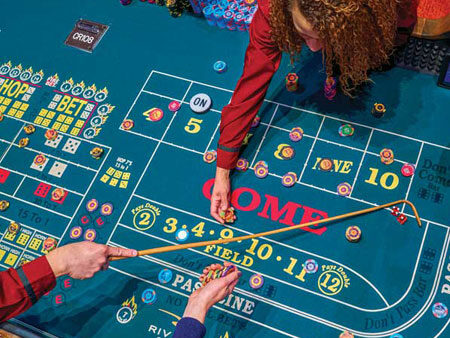Craps is a captivating and high-energy casino dice game that’s widely played in American casinos as well as in some British, Australian, and Asian gambling houses.
Known for its variety of betting options and dynamic gameplay, Craps involves players making bets against the house on the outcomes of rolls, or a series of rolls, of two six-sided dice.
Let’s learn more about how to play craps like the big players do it.
Key Takeaways
- Craps is an exhilarating dice game with multiple betting options.
- The game’s objective is to predict the outcome of the roll or series of rolls.
- Understanding the craps table layout and betting options is crucial for playing effectively.
The Craps Basics Explained
Craps is possibly the world’s most common gambling game with dice. Still, new players have a lot of questions they need answers to.
The game is distinctive for its special table and layout and involves the players betting against the house. A player signifies their bet by placing chips or cash on the appropriate part of the layout before any roll of the dice.
The dice needs to strike a wall of the table and bounce back to ensure randomness.
The Basic Setup of the Craps Table Layout and Equipment Used
The Craps table layout is uniquely designed, usually in an oval shape, featuring various areas for different types of bets.
Players bet on the outcome of the roll of two dice, which are the primary equipment in the game.
The shooter, who is the player throwing the dice, and other players at the table place bets on various outcomes predicted by the roll or series of rolls.
The layout of the table includes areas for Pass and Don’t Pass line bets, Come and Don’t Come bets, Field bets, Place bets, and Proposition bets.
Types of Bets in Craps
Craps offers a variety of bets, each with its own rules and payouts. Understanding these bets is crucial to play effectively:
- Pass Line Bet: This is the most fundamental bet in Craps. A bet on the pass line wins if the come-out roll is 7 or 11 and loses if it’s 2, 3, or 12. If any other number is rolled, it becomes the ‘point’, and the pass line bet wins if this point number is rolled again before a 7.
- Don’t Pass Line Bet: The opposite of the pass line bet. It wins if the come-out roll is 2 or 3, ties (no money changes hands) if a 12 is rolled, and loses if a 7 or 11 is rolled. If a point is established, the bet wins if a 7 is rolled before the point number.
- Come Bet: Similar to the pass line bet but made after the point is established. The next roll becomes the come-out roll for this bet. If a 7 or 11 is rolled, the come bet wins; if 2, 3, or 12 is rolled, it loses.
- Don’t Come Bet: The opposite of the come bet. It wins on a 2 or 3, ties on 12, and loses on 7 or 11. After a point is established, it wins if a 7 is rolled before the point number.
- Place Bets: This bet is on a specific number being rolled before a 7. You can bet on 4, 5, 6, 8, 9, or 10.
- Field Bet: A one-roll bet that wins if the next roll is a 2, 3, 4, 9, 10, 11, or 12. It typically pays even money, but some casinos offer higher payouts for 2 or 12.
- Proposition Bets: These are high-risk, single-roll bets with higher payouts. They include bets on specific number combinations or total values of the next roll.
- Hardway Bets: A bet on a specific pair of numbers being rolled ‘the hard way’ (as doubles) before a 7 or that number ‘the easy way’ (non-doubles). For example, a hardway bet on 8 wins if two 4s are rolled before a 7 or an easy 8.
- Big 6 and Big 8 Bets: Bets that 6 or 8 will be rolled before a 7. These are generally considered poor bets due to their high house edge.
Each of these bets has its own odds and strategies, making Craps a game with deep and interesting gameplay.
Understanding these bets, their odds, and when to place them will get you closer to mastering how to play craps.
Playing Craps: Table Etiquette and Tips
When playing Craps, etiquette is as important as understanding the game. Here are some key dos and don’ts:
Dos:
- Handle the dice with only one hand when throwing;
- Place your bets in a timely manner. Don’t delay the game;
- Be respectful to the dealers and other players;
- Wait for the dealer’s signal before placing new bets
Don’ts:
- Toss the dice too high or off the table. Aim for the back wall to ensure randomness;
- Say the word “seven” during a game. It’s considered bad luck;
- Touch your chips once the shooter has the dice;
- Over-celebrate. Be considerate of others, especially if they’re losing.
7 Tips for Beginners: How to Approach Your First Game
For beginners, approaching Craps can be daunting, but these tips can help:
- Start with Simple Bets: Focus on the basic bets like the Pass Line until you’re comfortable.
- Observe First: Watch a few rounds to understand the flow and etiquette.
- Set a Budget: Decide your betting limit beforehand and stick to it.
- Ask for Help: Don’t hesitate to ask the dealer for clarifications.
- Stay Calm: Keep your emotions in check, whether winning or losing.
- Learn the Lingo: Familiarize yourself with common Craps terms.
- Play for Fun: Remember, the goal is to enjoy the game.
I recommend you first try the craps simulator, before starting to play for real money.
Craps Variations
Different variations of Craps add diversity to the game:
- Bank Craps: The standard version found in most reputable Craps casinos;
- Crapless Craps: A variation where the player can’t lose on the come-out roll;
- Street Craps: A more informal version without a table, often played in casual settings.
Each variant has its own rules and nuances, offering unique experiences to players.
Conclusion
Now you have a complete overview of how to play Craps, an exhilarating and sociable game that combines luck, strategy, and the camaraderie of table games.
Understanding the Craps rules, betting strategies, and table etiquette can greatly enhance your gaming experience.
Always remember to gamble responsibly, setting limits for your play and treating it as a form of entertainment.
Enjoy the thrill of the dice, and may luck be on your side!













